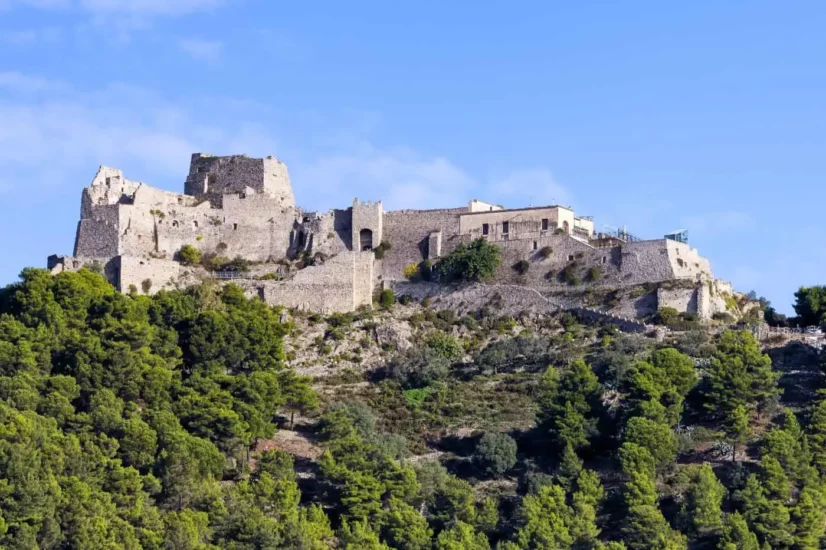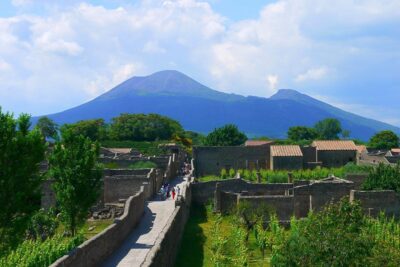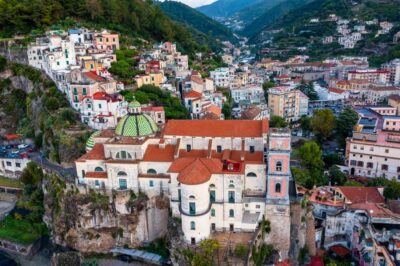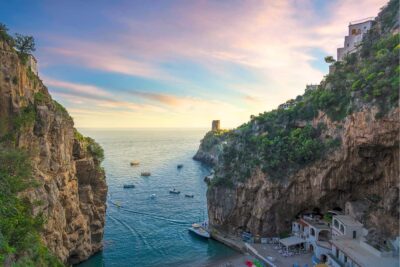Arechi Castle, located 300 metres above sea level, towers over and dominates the city and the Gulf of Salerno.
It is a tourist attraction in many ways: from a historical point of view, having been the fulcrum of city life for many centuries; from an engineering point of view, since it was the apex of a triangular defence system that made the city one of the safest and most fortified; from a geographical point of view, because it is in a strategic position, surrounded by wonderful vegetation and overlooking a spectacular view of the city and the sea.
After its adventures as the fulcrum of military life and the cradle of city life, today the castle is a tourist attraction where food and wine tours, ceremonies, events or conferences can be held. It also houses a small museum where the history of the building can be admired and relived.
Indice dei contenuti
The history of the Arechi Castle
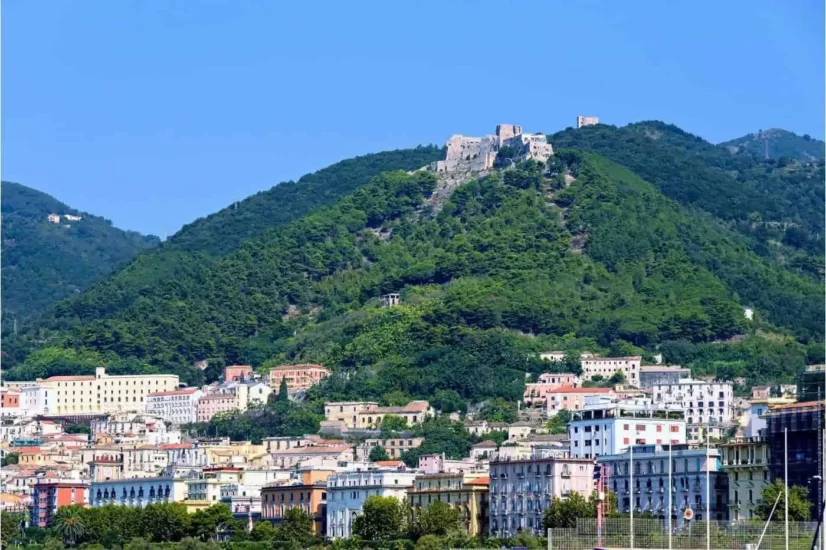
Arechi Castle stands on Mount Bonadies and dominates the city of Salerno from a height of 300 metres above sea level. The first structure of the building dates back to the 6th century, during the Greek-Gothic war. The remains of this Byzantine construction are evident in some sections of masonry made of tufa blocks and in the primitive layout of the main tower, which was initially all that existed of the castle we know today.
This tower, turris maior, was built on five levels and served to control the port and the roads leading to Nuceria Alfaterna, the hub of economic life on the Vesuvian plain.
During the 8th century, Arechi II made the castle the apex of a triangular defence system, whose walls descended along the Bonadies hill and enveloped the city as far as the sea. From here, the castle had an excellent position of control and defence. In fact, the stronghold never surrendered and it was only during the siege of Robert Guiscard that the occupants agreed to surrender for starvation. The Normans did not make any particular changes here, except for the extension of the structure through the construction of a loggia of which a few pillars remain today absorbed by the wall mass
To the same Normans we owe the construction of La Bastiglia tower, located to the north of the castle. It was built to remedy the poor visibility of certain movements directly from the castle.
The most far-reaching changes came with the Angevins, who added buildings and cisterns to the castle; they built curtains with vertical slits from which the defenders could shoot their arrows; below these were later installed rifle pits, which can still be seen today. The Angevins were also responsible for the construction of a thermal system that utilised the numerous cisterns present.
The ceramics found here are evidence that the castle also had a residential life. As well as Neapolitan and Florentine majolica and terracotta from nearby Vietri sul Mare, they are a sign that the building was also used as the residence of the lords of the time. When it lost its military and defensive function, it was used by the Sanseverino princes feudal lords of Salerno as a temporary residence.
The end of Sanseverino rule also marked the decline of the city and its castle. Ferrante Sanseverino took the castle as his residence, surrounding himself with outstanding artists and intellectuals, such as Bernardo Tasso, father of Torquato. Emperor Charles V was also a guest of the family. Ferrante tried to win against the Spanish Inquisition in the kingdom of Naples but was exiled. From then on, the decline was unstoppable. For years the castle was inhabited by shepherds and flocks, abandoned to decay and the elements.
Finally, after a period of abandonment after the Unification of Italy, the last owners of the castle, the Counts Quaranta, sold the fortress in 1960 to the Province of Salerno, which began the renovation work that brought the Arechi Castle to what we can see and admire today.
The Arechi Castle Museum
In addition to the possibility of celebrating weddings, organising events or parties , the Arechi Castle also houses a museum where exhibits from excavations carried out on the site can be found: ceramics, glass, metal objects and coins. The red-banded decorated pottery is represented by around four hundred fragments dating from the period between the 7th and 13th centuries.
They are characterised by a decoration with narrow spirals or wider bands describing consecutive arches. Equally important is the class of ware spiral ceramics, which can be dated between the 12th and 13th centuries. To this group belong the bowls and basins decorated with green and manganese brown spirals. A further ninety-eight finds are attributable to open forms.
Fascinating is a bowl decorated with three spirals separated by three green leaves with a double outline in brown. Many bowls are decorated with a green band bordered by straight or wavy lines in brown. Proto-Maiolica pottery, on the other hand, dates back to the 13th century and is glazed. Many bowls were found in the fortress, with flared walls and a ring foot.
Graffito pottery, on the other hand, belongs to the period between the 14th and 15th centuries; here, decoration was achieved by scratching the surface of objects with a fine point. The decoration was usually represented by plant or geometric motifs; only one animal representation consisted of a fish on the brim of a dish. This type of scratched pottery had a complex workmanship and, consequently, required a high level of affordability.
The glassware in the museum was brought to light during the excavations. These are also small or slightly larger fragments of tableware: glasses, bottles, cruets. Very thin and without decoration, they date back to the period between the 12th and 15th centuries. The decorations, where present, are either hot-applied on the stem of the chalices or glasses, or moulded.
The metals found, on the other hand, are numerous and can be traced back to the countless activities that took place inside the fortress. These are mostly bronze and iron artefacts from everyday life of the time: tacks, locks, pins, buckles, horseshoes. Numerous weapons have also been found, such as arrowheads, crossbow darts, spears.
Finally, the coins: of particular interest are three hoards. The first consists of denarii from the mint of Rouen, the capital of Normandy; silver coins minted between the 11th and early 12th century. The second consists of 21 gold coins found in a clay jug, belonging to the mint of Palermo or Messina. Finally, the third group of 22 silver coins and one copper coin with specimens from the mints of Macerata, Naples and Bologna dated between 1392 and 1534.
Opening Hours
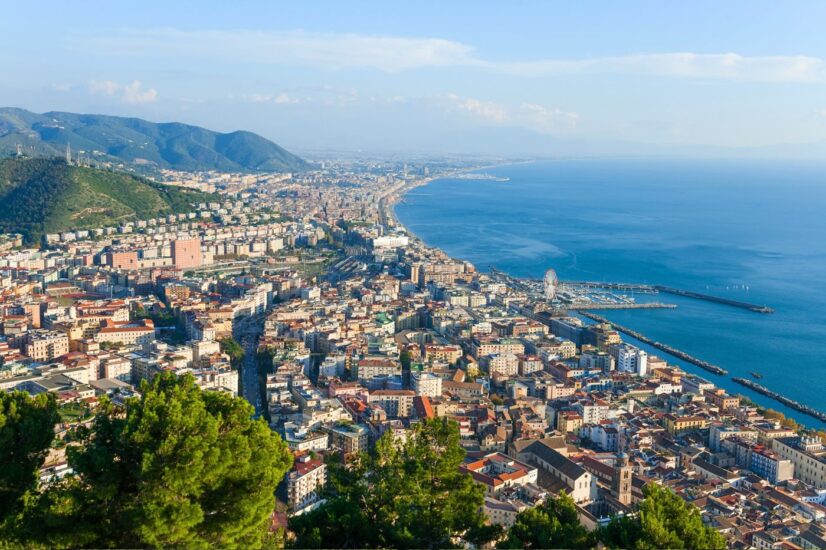
The Arechi Castle is now open to the public for visits to the internal museum with opening hours from 9.00 am to 5.00 pm. On Sundays, the ticket office closes at 3.30 p.m. and is closed on Mondays. With prior reservation, it is also possible to book a visit with a guide.
Access to the in-house libraries and archives, on the other hand, is open and free for reading and study purposes. It is also possible to make use of the various services, such as a conference room or other additional services of the building.
Finally, it is possible to celebrate weddings in a magical atmosphere, as well as organise themed events or wine and food evenings.
Among the possibilities there is also that of setting up an art exhibition displaying one’s own works, enjoying this captivating atmosphere that will give greater emphasis to the artistic event.
How to reach Castello Arechi from the Amalfi Coast
✅ By car: drive all the way along State Road 163 Amalfitana as far as Salerno. From here, proceed along the Tirrena Inferiore, take via Alfonso Gatto and then via Fra Generoso, until you reach Via Santa Croce.
✅ By bus: travel on SITA SUD buses to Salerno. Your stop is Lungomare Trieste Velia. From here take the 19 – Croce terminus. From the stop it is about a 5-minute walk to Arechi Castle.
Sita buses depart from Amalfi on average every hour and stop at all the towns on the coast. You can buy bus tickets at any authorised retailer displaying the “UNICO CAMPANIA” badge. Alternatively, download the UNICO App to purchase tickets from the comfort of your smartphone.
If you are looking for information on how best to organise your travels along the Amalfi Coast, download the free guide “How to get around the Amalfi Coast without stress”: a practical collection of tips and advice for travelling from place to place as if you had always lived here. Also included is a list of parking spaces on the Amalfi Coast!
Walking through the streets of the centre of Salerno to the Arechi Castle
If you love walking and would like to take the opportunity to explore the city of Salerno, we recommend that you walk to the Arechi Castle. Start at Salerno Cathedral and proceed towards the Monastery of Montevergine. You will then walk along the path leading to the Arechi Castle. From there, through a forest of holm oaks, you reach the Bastille, the watchtower located above the castle, from which sentries controlled the entire surrounding area.
From this point, if you are a keen trekker, you can proceed along the asphalt road that leads to Croce di Cava, reaching Monte San Liberatore.
Along the way you will admire the so-called ‘Cornice del principe’: a window from which to admire the city of Salerno from above, in all its beauty.

